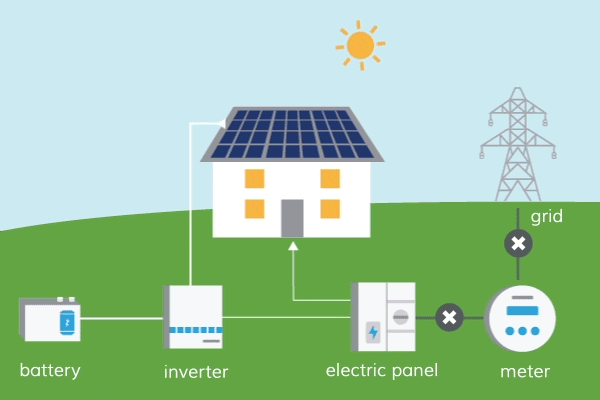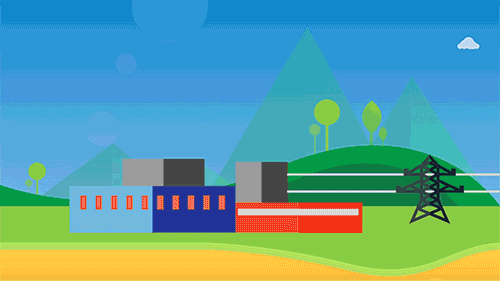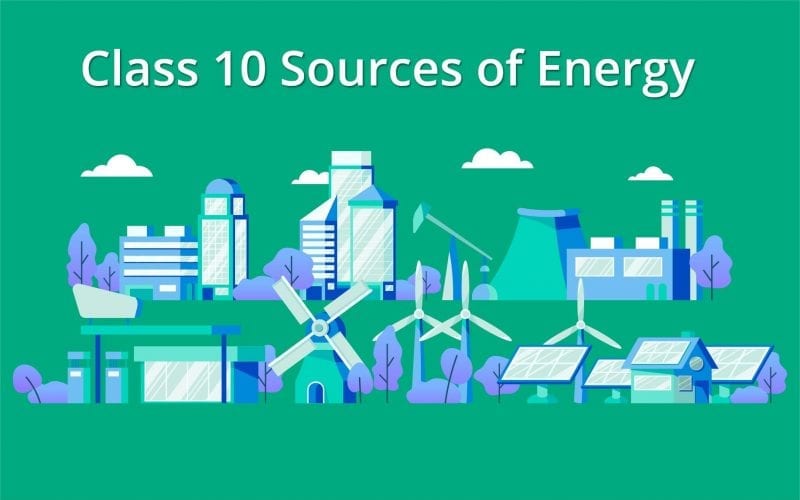Energy is derived from a wide range of sources, be it renewable or non-renewable. The 14th chapter of Class 10 Science defines what is a good source of energy and further elaborates upon varied sources of energy from commercial to non-commercial. You will also get to learn about renewable and non-renewable sources of energy in Class 10 Science along with fossil fuels, thermal power plants, biomass, to name a few. Looking for quick revision notes for Class 10 Science chapter on Sources of Energy? Here is a complete chapter summary as well as Class 10 Sources of Energy notes to help you ace your science exam!
This Blog Includes:
What is a Good Source of Energy?
The first concept you will study in Class 10 Sources of Energy notes is what defines a good energy source. Human beings utilize energy from various sources. For example, to run trains, we use diesel and to light the street lamp we use electricity. The most common example is how you use the energy in your muscles as you cycle your way back and forth to the school. Every energy has a source from physical work (muscular energy) to cooking food (chemical energy) and for running various appliances (electrical energy). We have to make a proper selection of the energy source to utilize energy in its usable form.
In contemporary times, there are plenty of options to choose a good source of energy. You must understand that an energy source that is good for cooking may not be the best option for producing electricity. According to Class 10 Science Chapter 14 on Sources of Energy, a good source of energy is:
- One that can do a large amount of work in terms of per unit mass or volume
- Easily accessible
- Easy to transport as well as store
- Cost-effective and economical
Similarly, while considering a fuel, here are the questions we need to ask:
- How much heat is produced when it is burned?
- Does it produce a lot of smoke?
- Is it easily available?
Conventional Sources of Energy
The next section of our Class 10 Sources of Energy notes summarizes the major conventional sources of energy covered in this chapter. There are two types of conventional sources of energy: commercial and non-commercial. Fossil fuel generally comes under commercial sources while firewood and dung cakes are non-commercial sources of energy.
Fossil Fuels
From time immemorial, humanity has been using wood as a reliable source of heat energy. The energy was also harnessed from flowing water and wind, although in a small amount. Coal is one of the significant sources of fossil fuel that leads to the Industrial Revolution’s culmination. As human civilizations continue to flourish and prosper, the surging demand for fuel was met mainly through fossil fuels like coal and petroleum. Our technology was also developed for using these energy sources. However, these fossil fuels have taken over a million years to form, and they are available in a minimal amount. Class 10 chapter on Sources of Energy notes that fossil fuel is non-renewable sources of energy, so we need to conserve them. The rates at which we use them are quite alarming, and it will not long before they are completely exhausted. Excess use of fossil fuels causes air pollution, which is another good reason to restrict its use.
Thermal Power Plant
Thermal Power Plant is heavily dependent on fossil fuel to generate steam from heated water. Steam, in turn, is used to run a turbine and produce electricity. It goes to explain why thermal power stations are located close to coal or oil fields. Have you ever wondered why it is called a thermal power plant? This is because, in a thermal power plant, the heat energy is converted into electrical energy
Hydro Power Plant
Another conventional source of energy is the flowing water or water stored at a great height. In a hydropower plant, the potential power of falling water is converted into electrical energy. Few waterfalls in the world can be used as a source of potential energy. Instead, over the last century, a large number of dams were built all over the world. At present, nearly a quarter of India’s total electricity requirements are fulfilled by hydropower plants.
Improvements in Technology for using Conventional Sources of Energy
The Class 10 Science chapter on Sources of Energy also notes the importance of improvement in technology so that we can efficiently use conventional sources of energy. With widespread industrialization and improved living standards, conventional energy sources are proving to be falling short of sufficing a surging demand for power. Hence, people are considering alternative energy sources to fulfil the growing demand. Our efforts to improve energy efficiency with technological improvement may not be enough to meet the urban requirements of electricity shortly. New or non-conventional sources have to be leveraged to fulfil our requirement of sustainable energy soon. Both developed and developing countries have their vision and goals for harnessing energy from alternative sources like solar energy and nuclear power plants.
Biomass
While studying Class 10 chapter on Sources of Energy, you will also learn about the utility of Biomass as a source of energy. Since it mainly contains plant and animal products, they are called Biomass. They do not produce much heat on burning and generate plenty of smoke. The only exception is charcoal, which burns smokeless and has higher heat generation efficiency. Like Biomass, we have the option of harnessing energy from biogas. In India, it is popularly known as Gobar gas. Here, compost is made from cow dung and plant materials like the residue left after harvesting crops, vegetable waste, and sewage in the absence of oxygen to produce biogas.
Wind Energy

In previous classes, you have learned how unequal heating of landmasses and water bodies generates air movement causing the wind to blow. The kinetic energy generated from the flow of air can be harnessed by windmills to produce electricity. One of the traditional uses of wind energy can be witnessed in drawing water from a well. It is important to study how wind energy is converted into mechanical energy while going through our Class 10 Sources of Energy notes.
When it comes down to the generation of electricity, the windmill’s rotator motion is used to turn the turbine of the electric generator. However, it has to be kept in mind that a single windmill cannot be used for the commercial production of electricity. However, in vast open spaces, you can lift hundreds of mills and collate their output to produce electricity on an industrial scale, also known as the wind energy farm.
Alternative or Non-Conventional Sources of Energy
Non-conventional sources of energy are considered cleaner sources as they do not produce undesirable waste in the form of smoke and toxic residues, which are detrimental to the environment. This Class 10 chapter also elaborates the alternative sources of energy that humanity has been seriously trying to harness to fulfil energy requirements in the present and near future. The major alternative or non-conventional sources of energy are:
- Solar Energy
- Energy from the Sea
- Geothermal Energy
- Nuclear Energy
Here are the study notes for these alternative or non-conventional sources of energy:
Solar Energy

The energy derived from the sun in the form of the heat radiated as well as light energy is referred to as solar energy. These radiations from the sun are converted into electricity with the help of solar cells or photovoltaic cells. These cells directly transmit the sun’s heat and light energy into electricity with the silicon solar cells which are arranged in the form of large flat sheets to create a mirror solar panel to trap sun’s heat and light. Solar cookers and solar heaters use the sun’s energy to either heat food or water respectively. The model of a solar cooker actually has black paint on the outside with an installed large glass plate that traps solar radiations thus creating a greenhouse effect. Solar cells are used across different industries such as:
- Artificial satellites & space probes
- Radio or wireless transmission
- TV relay stations in remote areas
- Traffic signals
- Calculators
- Cooking and electricity in rural areas
Energy from the Sea
As per our Class 10 Sources of Energy notes, here are the major sources of energy from the sea:
- Tidal Energy: This source of energy is derived from the rise of ocean water which happens due to the gravitational pull of the moon. This rise is called high tide and when it goes back, it is called low tide. Tidal energy comes from this constant and enormous movement of water with every high and low tide and is mainly used to build dams or tidal barrages.
- Wave Energy: The wave energy is produced by harnessing the kinetic energy of waves near the seashore which is then utilised to generate electricity. Turbines generally convert wave energy into electricity.
- Ocean Thermal Energy: As the water found at the sea surface is warmed by the sun and the water in the depth of the sea is relatively cold, the contrast in temperature is potentially used to convert energy in ocean-thermal plants.
Geothermal Energy

In deeper hot regions on the earth, the molten rocks often get stuck in certain areas with geological changes and these regions are referred to as hot spots. So, at times when underground water comes in contact with these hot spots, the generated steam is extracted through a pipe and then routed to a turbine and this way electricity is produced. This is a cost-effective and alternative source of energy covered in Class 10 Science. Finding the right viable sites to produce such energy is quite a cumbersome task and the major geothermal plants are located in New Zealand and the USA.
Nuclear Energy
Another alternative source of energy you must study while going through our Class 10 science notes is Nuclear Energy. This type of energy is formed through a proicess known as nuclear fission in which the nucleus taken from a heavy atom like thorium or uranium is blasted with low-energy neutrons and thus divided into lighter nuclei. This leads into a massive amount of energy release which is then utilised for electricity generation.
Important Questions
Here are the important questions you must practice after studying our Class 10 Sources of Energy notes:
- What, according to you, is a good source of energy, and how can you harness it?
- How do you describe a good fuel?
- List the disadvantages of fossil fuel.
- Why does humanity require alternative sources of energy?
Thus, we hope the Class 10 Sources of Energy notes helped you understand the essential concepts covered in this chapter! Confused about choosing the right stream after 10th? Our Leverage Edu experts are here to guide you in selecting the right stream of study to ensure that you make an informed decision towards a rewarding academic and professional quest! Sign up for a free session with us now!

 One app for all your study abroad needs
One app for all your study abroad needs





















 45,000+ students realised their study abroad dream with us. Take the first step today.
45,000+ students realised their study abroad dream with us. Take the first step today.

